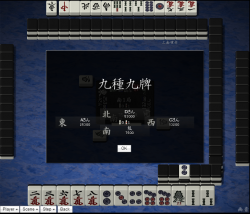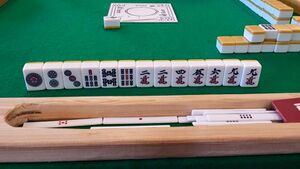Daburu riichi
| Type | Yaku |
|---|---|
| Kanji | 両立直 or ダブルリーチ |
| English | Double ready |
| Value | 2 han |
| Speed | Immediate |
| Difficulty | At discretion |
Daburu riichi 「両立直」 or 「ダブルリーチ」, or simply double riichi, is a special case for riichi on the first turn. Specifically, if the player reaches tenpai before their first discard (i.e., within the first 14 tiles), and before anyone has made a tile call, then riichi will automatically be converted into double riichi. Double riichi is worth 2 han instead of the usual 1 han (i.e., +1 han compared to riichi).
As with regular riichi, double riichi is not mandatory, but rarely do players decline an opportunity for it. In addition to the added han, a double riichi hand is inherently much faster than the average hand.
Cancellation
Double riichi is not possible when anyone makes a tile call before the riichi call, even if you reach tenpai on your first turn. Therefore, kan, even the player's own closed kan, will deny this yaku. In sanma, kita calls will also deny this yaku.
Tenhou and Chihou
It is very much possible to call a double riichi and be in furiten from the beginning. This can only be done with a hand qualifying for either tenhou or chiihou. However, this is a dubious play, either intentionally or unintentionally passing up yakuman. For this reason, it is unwise to be hasty about the prospect of a double riichi.
Compatibility
^ Ippatsu requires riichi to be of any use.
| RCH | DRI | IPP | SMO | TAN | PFU | IPK | ITT | YAK | SDJ | SDO | TOI | SNA | SNK | CHA | JUN | RPK | SSG | HRO | HON | CHN | CHI | RIN | HAI | HOU | CHK | |
| RCH | ||||||||||||||||||||||||||
| DRI |
Double riichi has the same compatibility as riichi, except for chankan. This is because, for a regular hand, chankan may only be formed from an added kan, which itself requires a call for pon to happen first.
- If the pon call happens before the riichi call, then double riichi is negated.
- If the pon call happens after the riichi call, then the double riichi player must have declined their winning tile, invoking furiten. Chankan can only be won from ron, so furiten prevents chankan entirely.
An exception is the yakuman kokushi musou. Depending on rule variation, kokushi may be won off a closed kan, which does not require a previous pon call. Therefore, in order to win with double riichi + chankan, it must also have kokushi. Since this would be a yakuman hand, the yaku of "chankan" is never actually scored.
Defending against double riichi

Double riichi's greatest advantage, aside from its speed, is the lack of information regarding safe tiles. Initially, every tile is considered to be dangerous, as no to few discarded tiles show any indication of safe tiles.
If you have nothing better, then honor tiles are the best to discard. Since honor tiles cannot form sequences, they are the least likely to be a winning tile. Guest winds are better than yakuhai as they do not give an extra han. Honor tiles with more copies visible are safer.
After a few discards, you can benefit from the furiten rule. When a player is in riichi, any discarded tile not claimed for a win is safe against that riichi. Therefore, safe tiles will rack up quickly. Eventually, players may reach tenpai and win for themselves.
The threat of double riichi can also be ended via abortive draw. Kyuushu kyuuhai can immediately end the hand before the declarer can claim tsumo, as can suufon renta. The other types of draw (suukaikan, suucha riichi, sanchahou) are usually too dangerous to rely on, but they can get you out of the hand.
External links

- Daburu riichi in Japanese Wikipedia
| |||||||||||||||||||||||||||||||
